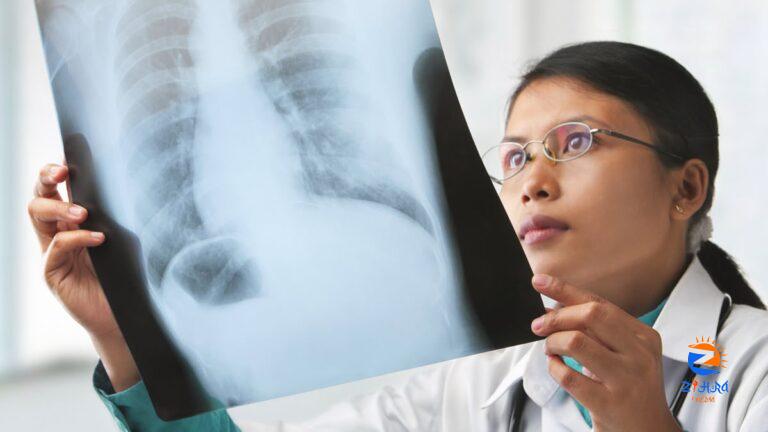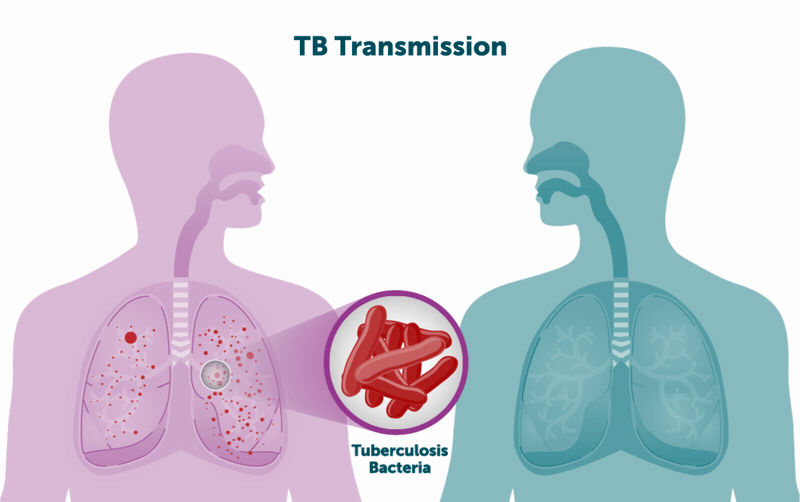
[ad_1]
Overview
If you are infected with TB germs, and if your body cannot stop TB germs from growing, you develop active TB disease.
TB disease usually affects the lungs, but it can also affect other parts of the body, such as the brain, the kidneys, or the spine. TB can also affect multiple parts of the body at the same time. For example, TB can affect both the lungs and lymph nodes.
A person with active TB disease:
- Has a large amount of active TB germs in their body.
- Has symptoms and feels sick.
- May spread TB germs to others.
- Usually has a positive TB blood test or TB skin test indicating TB infection.
- May have an abnormal chest x-ray, or positive sputum smear or culture.
- Needs treatment for active TB disease.
Signs and symptoms
Symptoms of active TB disease depend on where in the body the TB germs are growing.
Active TB disease in the lungs may cause:
- A cough that last three weeks or longer
- Chest pain
- Coughing up blood or sputum (phlegm from deep inside the lungs)
- Weakness or fatigue
- Weight loss
- Loss of appetite
- Chills
- Fever
- Night sweats
Symptoms of active TB disease in other parts of the body depend on the area affected:
- TB disease of the lymph nodes may cause a firm red or purple swelling under the skin.
- TB disease of the kidney may cause blood in the urine.
- TB meningitis (TB disease of the brain) may cause headache or confusion.
- TB disease of the spine may cause back pain.
- TB disease of the larynx may cause hoarseness.
How long it takes for signs to show
Some people develop active TB disease soon after becoming infected (within weeks) before their immune system can fight the TB germs. This is a particular risk for people who are taking certain medications or have health conditions such as diabetes, cancer, or HIV that may weaken their immune system.
Other people have inactive TB, also called latent TB infection.
Some people who have inactive TB never develop TB disease, and others with inactive TB develop active TB disease months or even years later when their immune system can no longer keep the TB germs from multiplying and growing in the body.
Without treatment, 1 in 10 people with inactive TB will get sick with active TB disease. Most people diagnosed with active TB disease in the United States become sick after living with inactive TB for years.
Risk factors
Anyone can get TB, but some people who have inactive TB are more likely to develop TB disease than others.
People at high risk for TB disease (once infected) fall into two categories:
- People who are taking certain medications or have health conditions such as diabetes, cancer, or HIV that may weaken their immune system; and
- People who have been recently infected with TB germs.
You may be at risk for TB even if you have received the TB vaccine (also called the Bacille Calmette-Guérin or BCG vaccine) because its protection weakens over time.
How it spreads
TB is spread through the air from one person to another. The TB germs are spread into the air when a person with active TB disease of the lungs or throat coughs, speaks, or sings. People may breathe in these TB germs and become infected.
When a person breathes in TB germs, the TB germs can settle in the lungs and begin to grow. From there, the TB germs can move through the blood to other parts of the body, such as the kidney, spine, or brain.

TB germs can stay in the air for several hours, depending on the environment. TB germs are more likely to spread in indoor areas or other places with poor air circulation (such as a closed vehicle) than in outdoor areas.
People with active TB disease are most likely to spread it to people they spend time with every day. This includes family members, friends, coworkers, or schoolmates. Health department staff may contact people who have spent time with a person with active TB disease to let them know they may have been exposed to TB germs and should get tested. This is called a contact investigation.
Prevention
Without treatment, people with inactive TB can develop active TB disease. If you have inactive TB, treating it is the best way to prevent active TB disease.
Some people with weakened immune systems (due to certain medications or health conditions) are at very high risk of developing active TB disease once infected with TB germs. It is very important that these people receive treatment for inactive TB to prevent the development of active TB disease.
Talk to your health care provider about your risk for TB.
If you have been exposed to active TB disease
Testing and diagnosis
Anyone with symptoms of TB disease or a positive TB blood test or TB skin test result should be evaluated by a health care provider for TB disease.
Medical evaluation for TB disease
A medical evaluation for TB disease includes:
- Medical history
- Physical examination
- Test for TB infection (TB blood test or TB skin test)
- Chest x-ray
- Laboratory tests to see if TB germs are present (sputum smear and culture)
- Laboratory tests for drug resistance
Testing for TB infection
There are two types of tests for TB infection: the TB blood test and the TB skin test. Ask your health care provider which TB test is best for you.
TB Blood Test
TB blood tests (also called interferon-gamma release assays or IGRAs) use a blood sample to find out if you are infected with TB germs. The tests measure how your immune system reacts when a small amount of your blood is mixed with TB proteins.
Tell your health care provider if you received a TB vaccine
Many people born outside the United States have received the TB vaccine (also known as Bacille Calmette-Guérin or BCG).
TB blood tests are the preferred test for people who have received the TB vaccine. Unlike the TB skin test, TB blood tests are not affected by BCG vaccination.
TB Skin Test
For the TB skin test, a health care provider uses a small needle to put some testing material under the skin. You will need to return to your health care provider in two to three days to see if there is a reaction.
Understanding TB Blood Test or TB Skin Test Results
A positive test result for TB infection means you have TB germs in your body. Your health care provider will do other tests to determine if you have inactive TB or active TB disease. These tests may include a chest x-ray, and a test of the sputum (phlegm) you cough up.
A negative test result for TB infection means inactive TB or active TB disease is unlikely, but your health care provider may do more tests, especially if:
- You have symptoms of active TB disease, like coughing, chest pain, fever, weight loss, or tiredness.
- You have HIV.
- You were recently exposed to TB germs.
Chest x-ray
Most people with TB disease have TB disease of the lungs. Your health care provider may use a chest x-ray to look for signs of TB disease in your lungs.
Laboratory tests
Your health care provider may collect samples from you. A common sample is a sputum (phlegm) specimen to test for TB of the lungs. Your health care provider may also collect a urine sample, take tissue samples, or do other tests. These tests can find TB germs that may be outside your lungs.
The laboratory will do tests, such as a smear test and a culture test to see whether there are TB germs in your sample. If the laboratory finds TB germs in your sample, they will also do tests to see which TB medicines can kill the TB germs.
Diagnosis
If you have symptoms of TB disease, a positive TB blood test or TB skin test and your health care provider finds evidence of active TB disease during the medical evaluation, you may be diagnosed with active TB disease.
Treatment
If you have active TB disease, you will take medicine to treat the disease. You will need to take and finish all of your TB medicine as directed by your health care provider. This is to help you feel better and prevent other people from getting sick.
If you have active TB disease, you will need to take several different TB medicines. This is because there are many TB germs to be killed. Taking several TB medicines will do a better job of killing all the TB germs and prevent them from becoming resistant to the medicines.
Depending on the TB treatment regimen your health care provider prescribes, treatment for TB disease may take four months, six months, or longer.
It is very important that you finish the medicine, taking the drugs exactly as prescribed:
- If you stop taking the drugs too soon, you can become sick again;
- if you do not take the drugs correctly, the TB germs that are still alive may become resistant to those drugs. TB that is resistant to drugs is harder to treat.
Directly Observed Therapy
The best way to remember to take your medicines for active TB disease is by receiving directly observed therapy (DOT). Through DOT, you will meet with a health care worker every day or several times a week. These meetings may be in-person or virtual (through a smartphone, tablet, or computer). The health care worker will watch you take your TB medicines and make sure that the TB medicines are working as they should.
[ad_2]